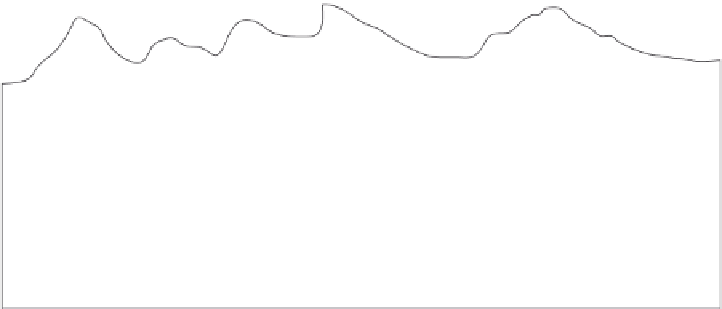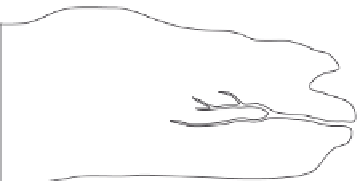Environmental Engineering Reference
In-Depth Information
precipitation
watershed of river
ridge line
tributary
R
surface runoff
I
V
surface runoff
river outlet
E
R
ground water in
ow
Figure 6.1.
Typical watershed.
surfaces include highway pavements, sidewalks, parking
lots, driveways, and rooftops. Roads and parking lots can
be the most significant type of land cover with respect
to stormwater, they constitute as much as 70% of total
impervious cover in ultra-urban landscapes, and as
much as 80% of the directly connected impervious
cover (NRC, 2009). As population density increases,
there are more emissions from cars, more pet waste and
litter deposited on impervious surfaces, more pesticides
and oils from parked vehicle drippings and mainte-
nance, and more of other wastes that are washed directly
into storm sewers or dumped into storm drains. As a
result of increased imperviousness, less rainfall perco-
lates into the ground and more flows overland, taking
with it the pollutants that accumulate on the impervious
surface.
Urban drainage systems deal with three types of
flows: wastewater (sewage) flow, stormwater runoff, and
infiltration inflow. Wastewater flows are typically routed
to a wastewater treatment plant and treated prior to
discharge through a pipe or diffuser into a receiving
body. Stormwater runoff occurs during wet weather
conditions and originates from streets, roads, and other
impervious areas. Flows in drainage systems also occur
under dry weather conditions from sources, such as
irrigation and infiltration inflow from groundwater and
other activities, such as washing cars. The term
urban
runoff
collectively refers to water from rain, irrigation,
or other sources that flows over the land surface in an
urban setting, carrying chemicals, microorganisms,
excessive sediments, and other contaminants directly
into receiving waters and causing pollution. In some
cases, particularly in older cities, wastewater flows and
stormwater runoff are combined into a single pipe that
runs to a wastewater treatment plant, and combined
flows in excess of the plant capacity are discharged
without treatment into a receiving water body. Infiltra-
tion inflow into sewers originates from groundwater
infiltration into sewer pipes, leaking street manhole
covers, cross-connections with stormwater conduits, and
other sources. Although infiltration inflow tends to be
clean water, it increases the volume of flow in the con-
duits and increases the frequency of overflows of
untreated wastewater from sewer systems that bypass
the treatment plant, thereby increasing the volume
of pollutant entering receiving water bodies. Other del-
eterious effects of infiltration inflow are that the waste-
water arrives at the treatment plant diluted, which
decreases the efficiency of the treatment process.
In areas that are
less pervious (less than 40%































































Search WWH ::

Custom Search